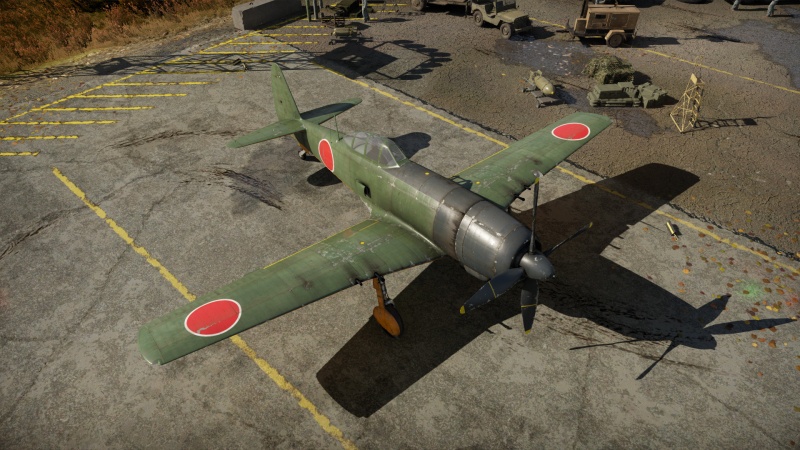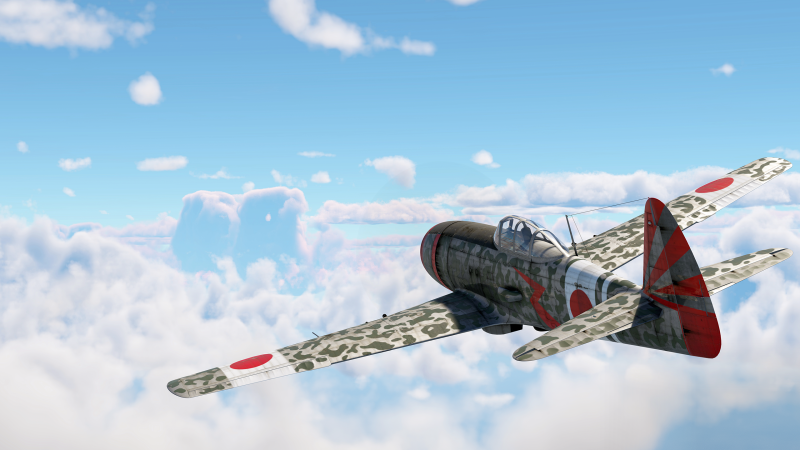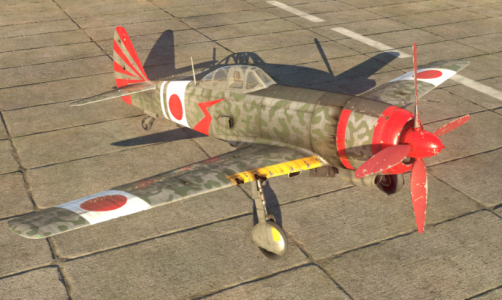Difference between revisions of "Ki-94-II"
m (→Description) |
(→Pros and cons: Outdated information about 30mm canons (velocity change/nerf was not considered)) (Tag: Visual edit) |
||
| (3 intermediate revisions by one other user not shown) | |||
| Line 7: | Line 7: | ||
== Description == | == Description == | ||
<!-- ''In the description, the first part should be about the history of and the creation and combat usage of the aircraft, as well as its key features. In the second part, tell the reader about the aircraft in the game. Insert a screenshot of the vehicle, so that if the novice player does not remember the vehicle by name, he will immediately understand what kind of vehicle the article is talking about.'' --> | <!-- ''In the description, the first part should be about the history of and the creation and combat usage of the aircraft, as well as its key features. In the second part, tell the reader about the aircraft in the game. Insert a screenshot of the vehicle, so that if the novice player does not remember the vehicle by name, he will immediately understand what kind of vehicle the article is talking about.'' --> | ||
| − | The '''{{Specs|name}}''' was a single-seat, piston-engine fighter designed by Tachikawa Aircraft Company for the Imperial Japanese Army Air | + | The '''{{Specs|name}}''' was a single-seat, piston-engine fighter designed by Tachikawa Aircraft Company for the Imperial Japanese Army Air Service. It was intended to intercept high-altitude B-29 bombers with a pressurized cockpit and four wing-mounted autocannons. The project started in 1943 as a revised version of the earlier Ki-94-I, which was a twin-boom push-pull design that was rejected as too complex. The Ki-94-II had a powerful Nakajima Ha-219 (Ha-44) engine and a six-blade propeller, but it never flew before the end of World War II. Only two prototypes were built, one of which was still being prepared for its maiden flight when the war ended with a four-blade propeller. |
It was introduced during [[Update 1.69 "Regia Aeronautica"]] in the [[wt:en/news/4868/current|"Operation S.U.M.M.E.R." event of 2017]] after earning 13 pilot Marks of Distinction. The Ki-94-II is a prop aircraft designed for bomber intercepting and high-altitude combat. It has a powerful engine, long wings, and a responsive elevator, but a poor climb rate and engine response. It should use Boom-&-Zoom tactics when above the enemy, and Boom-&-Run tactics when at the same altitude. It should avoid turning fights with Spitfires, and use flaps, elevator keys and throttle control to out-turn P-47s and P-51Ds. It should also stay near teammates and watch out for its vulnerable fuel tanks. | It was introduced during [[Update 1.69 "Regia Aeronautica"]] in the [[wt:en/news/4868/current|"Operation S.U.M.M.E.R." event of 2017]] after earning 13 pilot Marks of Distinction. The Ki-94-II is a prop aircraft designed for bomber intercepting and high-altitude combat. It has a powerful engine, long wings, and a responsive elevator, but a poor climb rate and engine response. It should use Boom-&-Zoom tactics when above the enemy, and Boom-&-Run tactics when at the same altitude. It should avoid turning fights with Spitfires, and use flaps, elevator keys and throttle control to out-turn P-47s and P-51Ds. It should also stay near teammates and watch out for its vulnerable fuel tanks. | ||
| Line 136: | Line 136: | ||
'''Pros:''' | '''Pros:''' | ||
| − | * | + | * Good firepower, thanks to 30 mm cannons |
* Efficient ammunition usage thanks to slow firing cannons and having more ammo than other rank IV Japanese fighters | * Efficient ammunition usage thanks to slow firing cannons and having more ammo than other rank IV Japanese fighters | ||
* Good roll rate | * Good roll rate | ||
| Line 154: | Line 154: | ||
== History == | == History == | ||
<!-- ''Describe the history of the creation and combat usage of the aircraft in more detail than in the introduction. If the historical reference turns out to be too long, take it to a separate article, taking a link to the article about the vehicle and adding a block "/History" (example: <nowiki>https://wiki.warthunder.com/(Vehicle-name)/History</nowiki>) and add a link to it here using the <code>main</code> template. Be sure to reference text and sources by using <code><nowiki><ref></ref></nowiki></code>, as well as adding them at the end of the article with <code><nowiki><references /></nowiki></code>. This section may also include the vehicle's dev blog entry (if applicable) and the in-game encyclopedia description (under <code><nowiki>=== In-game description ===</nowiki></code>, also if applicable).'' --> | <!-- ''Describe the history of the creation and combat usage of the aircraft in more detail than in the introduction. If the historical reference turns out to be too long, take it to a separate article, taking a link to the article about the vehicle and adding a block "/History" (example: <nowiki>https://wiki.warthunder.com/(Vehicle-name)/History</nowiki>) and add a link to it here using the <code>main</code> template. Be sure to reference text and sources by using <code><nowiki><ref></ref></nowiki></code>, as well as adding them at the end of the article with <code><nowiki><references /></nowiki></code>. This section may also include the vehicle's dev blog entry (if applicable) and the in-game encyclopedia description (under <code><nowiki>=== In-game description ===</nowiki></code>, also if applicable).'' --> | ||
| − | The Ki-94-II was Tachikawa Aircraft Company's response to the Japanese Imperial Army Air | + | The Ki-94-II was Tachikawa Aircraft Company's response to the Japanese Imperial Army Air Service demands for a fast, high altitude interceptor featuring heavy armament as soon as Japanese intelligence learned about the B-29 to counter the B-29 raids as the aircraft available at that time for the IJAAS were inadequate to combat B-29s. The Ki-94-II was developed from the original Ki-94; the Ki-94-I which was an experimental high altitude interceptor with 2 propellers and a twin-tailed boom configuration (such as the tail of the Venom and the Vampire), one was a normal propeller on the front and the other was a pusher prop on the back. The Ki-94-II was created by Tatsuo Hasegawa. There were 2 prototypes of the Ki-94-II, one was fitted with a 4-blade propeller and the other one was to be fitted with a 6-blade propeller however the war ended before any of the prototypes made their maiden flight so the project was cancelled. The aircraft had 2 x 20 mm Ho-5 cannons and 2 x 30 mm Ho-155-I cannons, 150 rpg per 20 mm and 30 mm, 600 rounds in total. |
== Media == | == Media == | ||
| Line 160: | Line 160: | ||
;Skins | ;Skins | ||
| + | |||
* [https://live.warthunder.com/feed/camouflages/?vehicle=ki_94_2 Skins and camouflages for the {{PAGENAME}} from live.warthunder.com.] | * [https://live.warthunder.com/feed/camouflages/?vehicle=ki_94_2 Skins and camouflages for the {{PAGENAME}} from live.warthunder.com.] | ||
| Line 172: | Line 173: | ||
== See also == | == See also == | ||
''Links to the articles on the War Thunder Wiki that you think will be useful for the reader, for example:'' | ''Links to the articles on the War Thunder Wiki that you think will be useful for the reader, for example:'' | ||
| + | |||
* ''reference to the series of the aircraft;'' | * ''reference to the series of the aircraft;'' | ||
* ''links to approximate analogues of other nations and research trees.'' | * ''links to approximate analogues of other nations and research trees.'' | ||
Latest revision as of 12:00, 24 October 2024
Contents
Description
The Ki-94-II was a single-seat, piston-engine fighter designed by Tachikawa Aircraft Company for the Imperial Japanese Army Air Service. It was intended to intercept high-altitude B-29 bombers with a pressurized cockpit and four wing-mounted autocannons. The project started in 1943 as a revised version of the earlier Ki-94-I, which was a twin-boom push-pull design that was rejected as too complex. The Ki-94-II had a powerful Nakajima Ha-219 (Ha-44) engine and a six-blade propeller, but it never flew before the end of World War II. Only two prototypes were built, one of which was still being prepared for its maiden flight when the war ended with a four-blade propeller.
It was introduced during Update 1.69 "Regia Aeronautica" in the "Operation S.U.M.M.E.R." event of 2017 after earning 13 pilot Marks of Distinction. The Ki-94-II is a prop aircraft designed for bomber intercepting and high-altitude combat. It has a powerful engine, long wings, and a responsive elevator, but a poor climb rate and engine response. It should use Boom-&-Zoom tactics when above the enemy, and Boom-&-Run tactics when at the same altitude. It should avoid turning fights with Spitfires, and use flaps, elevator keys and throttle control to out-turn P-47s and P-51Ds. It should also stay near teammates and watch out for its vulnerable fuel tanks.
General info
Flight performance
| Characteristics | Max Speed (km/h at 12,000 m) |
Max altitude (metres) |
Turn time (seconds) |
Rate of climb (metres/second) |
Take-off run (metres) | |||
|---|---|---|---|---|---|---|---|---|
| AB | RB | AB | RB | AB | RB | |||
| Stock | 687 | 673 | 14000 | 24.6 | 25.1 | 11.6 | 13.5 | 600 |
| Upgraded | 748 | 720 | 21.8 | 23.0 | 21.8 | 17.0 | ||
Details
| Features | ||||
|---|---|---|---|---|
| Combat flaps | Take-off flaps | Landing flaps | Air brakes | Arrestor gear |
| ✓ | ✓ | ✓ | X | X |
| Limits | ||||||
|---|---|---|---|---|---|---|
| Wings (km/h) | Gear (km/h) | Flaps (km/h) | Max Static G | |||
| Combat | Take-off | Landing | + | - | ||
| 850 | 280 | 580 | 471 | 280 | ~11 | ~6 |
| Optimal velocities (km/h) | |||
|---|---|---|---|
| Ailerons | Rudder | Elevators | Radiator |
| < 510 | < 450 | < 460 | > 324 |
Survivability and armour
There is limited armour protection for the pilot and other modules, but the coverage is not high. All the main modules - engine, fuel tanks, oil coolers - are located in the front of the fuselage and the inner part of the wings. This means the modules would likely absorb bullets coming from the front before they could harm the pilot, but the aircraft would likely be crippled after that. From the rear there are no major modules, but that also leaves the pilot very vulnerable from the rear.
- 70 mm Bulletproof glass - Armoured windscreen
- 8.5 mm Steel plate in the nose, behind engine
Modifications and economy
Armaments
Offensive armament
The Ki-94-II is armed with:
- 2 x 30 mm Ho-155 cannons, wing-mounted (100 rpg = 200 total)
- 2 x 20 mm Ho-5 cannons, wing-mounted (200 rpg = 400 total)
Suspended armament
The Ki-94-II can be outfitted with the following ordnance:
- Without load
- 2 x 50 kg Army Type 94 GPHE bombs (100 kg total)
- 2 x 250 kg Army Type 92 GPHE bombs (500 kg total)
Usage in battles
The Tachikawa Ki-94-II should be used as a Boom & Zoomer and a Boom & Runner depending on the situation. The Ki-94-II should be above all enemy aircraft in order to Boom & Zoom. When used as a Boom & Zoomer, set the throttle to 20%-50%. The reason behind that is the Ki-94-II's engine response to throttle change from 0% to 100% or WEP is poor, it takes 5 seconds or more for the engine to go back to full power which can be a leave the plane really vulnerable if you're trying to climbing back to altitude without engine power. If you meet players at your height, that's when Boom & Run comes into place. After going head-on with them (if you do), do not turn back to them. Level your plane out and keep flying straight to gain speed and keep doing that until the enemy pilot turns away. After that, climb more then resume Boom & Zoom.
The Ki-94-II has a powerful engine, producing up to 2,440 hp in-game. It has long wings which resemble the ones of the Ta 152. The Ki-94-II's elevator is very responsive at 500-700 km/h which is impressive for a prop aircraft. However, the climb rate of the Ki-94-II is abysmal without modifications. With all modifications, it can climb with P-47s. The Ki-94-II is a durable plane, it can take quite a few hits to its airframe without dying immediately. However, the fuel tanks are not well-protected, so expect them to get lit on fire fairly easily.
The Ki-94-II's main role is bomber intercepting but it can also be used as a fighter. As said earlier, the Ki-94-II should climb above all enemies by side-climbing to Boom & Zoom. Boom & Run is used if you and another enemy are at the same altitude, level the plane out and keep flying straight until the enemy turns away. Stick to your teammates in case you need help.
Spitfires are your worse enemy. They climb and turn better. P-47s can be problematic, but the Ki-94-II can out-turn them with proper use of flaps, elevator keys and throttle control. P-51Ds can also be an issue of the pilots behind them know what they're doing. Bombers such as the B-17, the B-24 and the B-29 are not much of a threat as the Ki-94-II's main role is to intercept them, however look out for their gunners as they can be deadly.
Manual Engine Control
| MEC elements | ||||||
|---|---|---|---|---|---|---|
| Mixer | Pitch | Radiator | Supercharger | Turbocharger | ||
| Oil | Water | Type | ||||
| Controllable | Controllable Not auto controlled |
Controllable Not auto controlled |
Controllable Not auto controlled |
Separate | Controllable 2 gears |
Not controllable |
Pros and cons
Pros:
- Good firepower, thanks to 30 mm cannons
- Efficient ammunition usage thanks to slow firing cannons and having more ammo than other rank IV Japanese fighters
- Good roll rate
- High red-line speed of over 800 km/h
- Excellent at high speed turning, retains good control and energy at speed
- Strong and effective flaps
Cons:
- Horrible stock performance
- Default belts for the 20 mm is not good, although 30 mm is decent
- Engine response to throttle is poor; takes approximately 5 or more seconds for the engine to go back to full power after setting it from 0% to 100% or WEP
- Mediocre acceleration overall
- Mediocre climb rate compared to planes at battle rating
- Is bested by most fighters unless at extremely high altitudes
History
The Ki-94-II was Tachikawa Aircraft Company's response to the Japanese Imperial Army Air Service demands for a fast, high altitude interceptor featuring heavy armament as soon as Japanese intelligence learned about the B-29 to counter the B-29 raids as the aircraft available at that time for the IJAAS were inadequate to combat B-29s. The Ki-94-II was developed from the original Ki-94; the Ki-94-I which was an experimental high altitude interceptor with 2 propellers and a twin-tailed boom configuration (such as the tail of the Venom and the Vampire), one was a normal propeller on the front and the other was a pusher prop on the back. The Ki-94-II was created by Tatsuo Hasegawa. There were 2 prototypes of the Ki-94-II, one was fitted with a 4-blade propeller and the other one was to be fitted with a 6-blade propeller however the war ended before any of the prototypes made their maiden flight so the project was cancelled. The aircraft had 2 x 20 mm Ho-5 cannons and 2 x 30 mm Ho-155-I cannons, 150 rpg per 20 mm and 30 mm, 600 rounds in total.
Media
- Skins
- Images
- Videos
See also
Links to the articles on the War Thunder Wiki that you think will be useful for the reader, for example:
- reference to the series of the aircraft;
- links to approximate analogues of other nations and research trees.
External links
| Tachikawa Aircraft Company, Limited (立川飛行機株式会社) | |
|---|---|
| Fighters | Ki-94-II |
| Japan fighters | |
|---|---|
| Navy | |
| Carrier-based fighter | |
| A5M | A5M4 · Hagiri's A5M4 |
| A6M | A6M2 mod. 11 · A6M2 · A6M3 · A6M3 mod. 22 · A6M3 mod. 22Ko · A6M5 · A6M5 Ko · A6M5 otsu · A6M5 Hei · A6M6c |
| A7He | A7He1* |
| A7M | A7M1 (NK9H) · A7M2 |
| Land-based Fighter | |
| J2M | J2M2 · J2M3 · J2M4 Kai · J2M5 · J2M5 (30 mm) |
| J6K | J6K1 |
| J7W | J7W1 |
| N1K-J | N1K1-Ja · N1K2-J · N1K2-Ja |
| Fighter seaplane | |
| N1K | N1K1 |
| A6M-N | A6M2-N |
| Army | |
| Ki-10 | Ki-10-I · Ki-10-I C · Ki-10-II · Ki-10-II C |
| Ki-27 | Ki-27 otsu · Ki-27 otsu Tachiarai |
| Ki-43 | Ki-43-I · Ki-43-II · Ki-43-III otsu |
| Ki-44 | Ki-44-I · Ki-44-I 34 · Ki-44-II otsu · Ki-44-II hei |
| Ki-61 | Ki-61-I ko · Ki-61-I otsu · Ki-61-I hei · Tada's Ki-61-I hei · Ki-61-I tei · Ki-61-II Otsu Kai |
| Ki-84 | Ki-84 ko · Ki-84 otsu · Ki-84 hei |
| Ki-87 | Ki-87 |
| Ki-94 | Ki-94-II |
| Ki-100 | Ki-100 · Ki-100-II |
| Other countries | ▅F4U-1A · ▅P-51C-11-NT · ▅Bf 109 E-7 · ▅Fw 190 A-5 |
| *Imported designation of the He 112 (A6M was in development - A7M would take A7 designation after the cancelation of the A7He) | |







